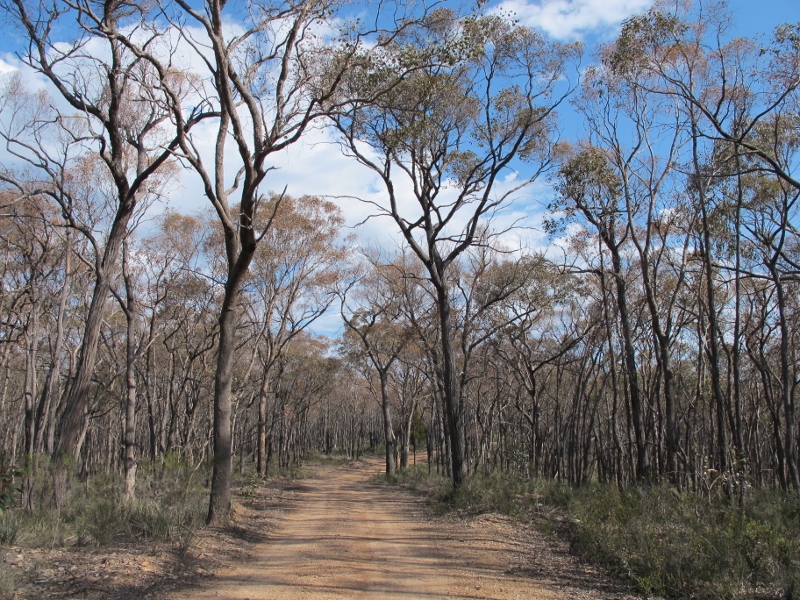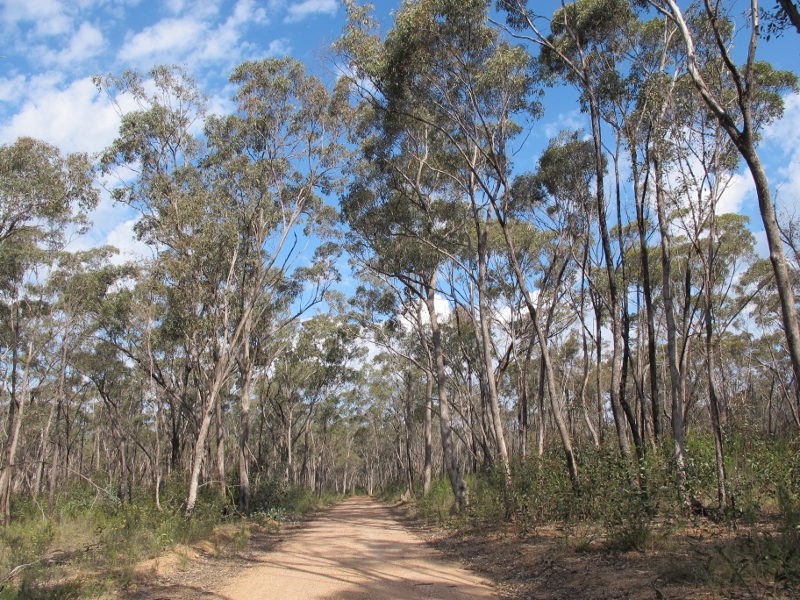The cup moth [Doratifera] grub is at it again: the damage perhaps a bit patchier than the last infestation. The grub is pretty undiscriminating in its appetite, but appears to prefer stringybarks [Eucalyptus macrohyncha] in our area. The Bendigo Field Naturalists Eucalypt guide notes that this tree ‘is subject to annual, often very severe defoliation by the caterpillars of the cup moth. This places considerable stress on the trees, but almost certainly has its compensations in the form of reduced waterloss through reduced leaf area during summer, and improved nutrient recycling…’
The patchiness of the present infestation can be seen in the two photos below, taken less than two kilometres apart. In the first, the Maldon Historic Reserve seems completely untouched:
In the second, a couple of kilometres down the road, the devastation is clear. The second photo is taken in bush with heavier concentrations of stringybarks:

A couple of kilometres down the same track, on the same day: bushland with greater numbers of stringybarks is heavily defoliated.
How well does the bush recover from these infestations? Trees trashed a couple of years ago seem, on the whole, to have gotten over the attacks. On the other hand, our understanding of these matters is limited. As forestry researchers noted [in Australian Forestry June 2010, in reference to similar outbreaks in Gippsland early this century,
‘The cause of the outbreaks by Doratifera spp. is uncertain because of insufficient knowledge concerning their lifecycle. While climatic factors are likely triggers, other factors such as eucalypt host susceptibility, foliage nutritional status, altitude, forest type,
soils and geology may also influence the occurrence of Doratifera spp. outbreaks. Further, it still has to be determined whether the factors that trigger outbreaks affect Doratifera spp. directly or reduce parasitoid/predator populations that usually keep Doratifera spp. populations in check. As little is known of the predisposing factors for outbreaks (especially for Doratifera spp.), the appropriate nature and timing of any potential control measures are difficult to identify. Continued monitoring of all potential damaging insect pest populations and associated canopy cover is recommended as part of a structured forest health surveillance system in order to predict outbreaks and allow appropriate contingency plans to be made if required. However, as most native insect outbreaks in native forests are short term and part of the normal forest ecosystem, the implementation of control measures is usually not required. The potential for long-term effects of drought to increase outbreak frequency and subsequently affect tree growth and health should not be discounted, thus emphasising the need for regular monitoring.’





 Click on image for info/order page
Click on image for info/order page Click on image for info/order page
Click on image for info/order page Click on image for info/order page
Click on image for info/order page




















